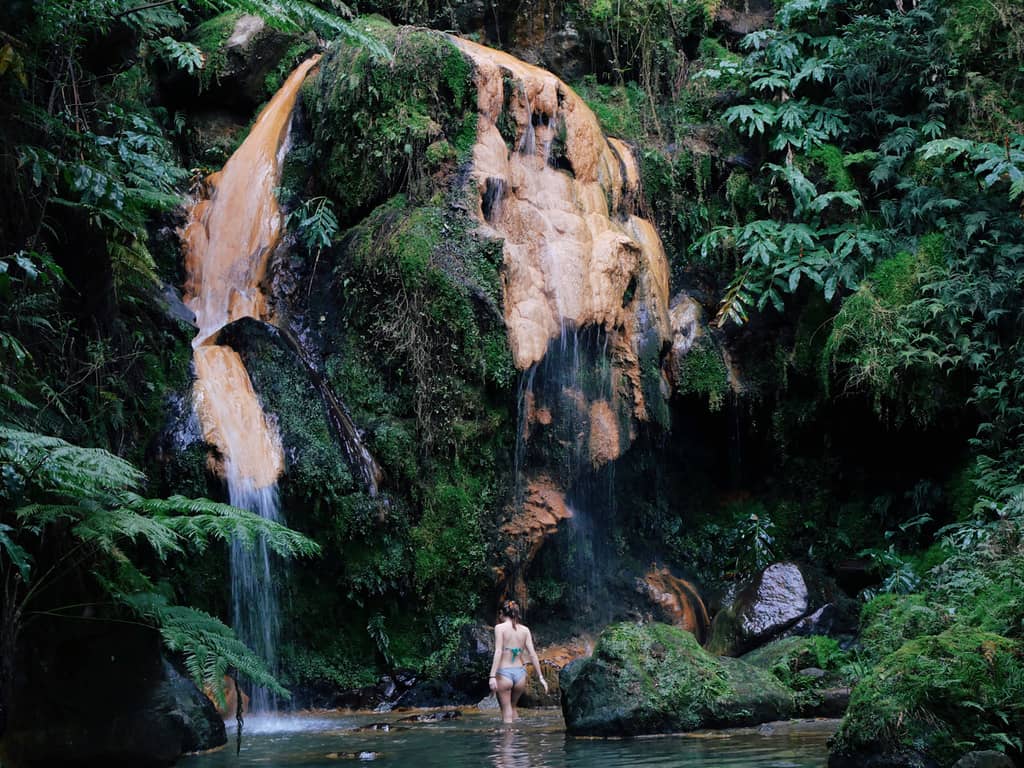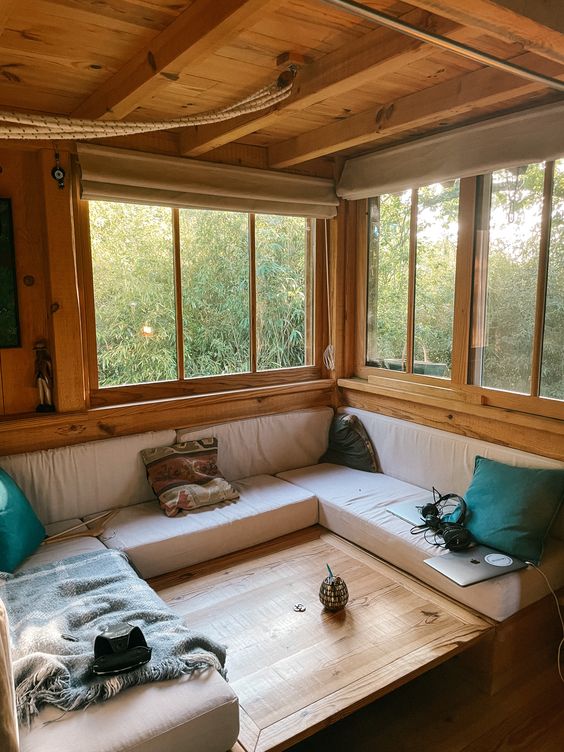Behind the picture-perfect IG shots lays a ditch that no one wants to see. Here's what you should know before renting a tiny house.
CONFESSIONS OF A TINY HOUSE DWELLER: WHY I WON’T DO IT AGAIN
#mindYou’ve probably seen a photo of a tiny house before. Often, you see a woman wrapped in a cosy blanket, cup of coffee in hand, gazing through the large windows of her modern cabin, and enjoying a view of tranquillity and greenery.
Three years ago, I came across the concept of tiny houses and hit my first “like” on a photo. Since then, the algorithm has been suggesting more, each one more appealing than the previous.
I started dreaming about it at night. A micro-chalet in the woods near the sea, far away from the noise of cars and urban ugliness, now that’s happiness.
And then, the opportunity presented itself. I was looking for accommodation in the Basque Country for May and June, and a *small* tiny house became available. Just a five-minute drive from ten surf spots, yet nestled in the countryside with a view of the Pyrénées mountains. So, I took the leap with my partner. We set up for two months of “tiny house living.”
--
The scent of damp wood fills the air. Everything is made of solid oak, with a slight amber hue: the floor, the walls, the doors, the furniture, and the ceiling. As soon as you enter the cabin, the owners’ history reveals itself through various objects on the shelves. Their love for surfing and travel is evident, with trinkets collected from all over the world — an engraving from the Mentawai Islands, a jute basket from Namibia, Moroccan tableware with delicate shades of blue. Despite the limited space (18m²), the large windows opening onto a green oasis give a (small) sense of grandeur. Sometimes, you can even spot deer in the distance.
The living room/kitchen space is functional, with hidden storage compartments scattered around. Angled benches serve as a sofa bed, with a modular table in the middle that we can raise with a thick rope attached to the ceiling. It feels like being on a boat, surrounded by bamboo.
Upstairs, a small mezzanine with a double bed and a window that looks out into the sky.
Outside, a weeping willow and its swing. Every time I open the garden door, I feel ike a fairy dancing among the strands of this majestic tree, gently parting them from side to side to make my way through. A table on the terrace and four chairs can accommodate friends on sunny days.
Here, there’s no sound of traffic. You hear birds, bees, and cows.
My favourite moment is the morning. The sun is gentle, the air is fresh, and the birds sing.
Concentrating on their birdsong is like an auditory meditation for me. While making my Italian coffee, I listen. Everything stops. Suddenly, I am the girl in the photo. Wrapped in my cosy blanket, cup of coffee in hand, I gaze at a view of tranquillity and greenery.
Well, it sounds dreamy, doesn’t it?
Let me stop you right there. I’ve been living in this tiny house for two months. And I’ve had enough. Really. It’s enough to make you want to pull your hair out. Let me explain why.
It’s wild how much nonsense we share on social media. I’m guilty of it too. Me with my IG stories, parading in my garden, filming my Instagrammable kitchen as the coffee heats up. When the truth is, all I want is to get out of here.
It was fine at first. Then the rain came. Ten days in a row. Non-stop. Anyone would lose it, even in a big house. But in a tiny home, you can’t even imagine. It’s mental chaos. There’s no room to move. You’re curled up, trying to find a comfortable position to read, work, or watch TV. Everything is too…compact. You bump your toes on every corner. Clothes overflow because there’s no wardrobe. It’s impossible to dry anything because of the humidity. Your wetsuits are destined to stay wet throughout May.
And then you spend hours looking for something: your car keys, your pyjamas, the charger. Oddly enough, you lose everything when you live in a small space. You can’t see anything anymore. It’s like Ali Baba’s cave. So, living in a tiny house means spending most of your time searching and tidying up.
And what about when the weather is nice?
You might think it’s bliss. You can chill in the spacious garden, sunbathe in peace, and sip your fruit juice in the sun.
If only I knew.
If your tiny house is near a farm with cows, and you plan to stay there in the summer, run away. It’s not worth it.
As soon as you step outside, hundreds of flies attack you like a herd of bulls. They stick to you like leeches. Your electric racket becomes your weapon of choice, and you take sadistic pleasure in watching the flies slowly burn, trapped between the grates. And throughout this fiasco, you’ve been bitten ten times by mosquitoes.
In the evening, all sorts of slimy insects invade the cabin. They’re everywhere. In your clothes, shoes, pillows. They leave trails of slime. Charming.
You might say, “Well, insects are everywhere in the countryside.” That’s true. But the frustration is overwhelming when you live in a tiny cabin and can’t even go outside.

Imagine not being able to enjoy this garden!
Why did I give up on living in a tiny house?
It’s fascinating how much our environment can influence our mood and well-being. Yet, all the elements were there for me to have two months of happiness: nature, tranquillity, waves nearby, a glimpse of the mountains, and just enough to enjoy life. But I shaped my experience based on preconceived expectations. And often, those expectations are exaggerated for places we’ve seen too much on Instagram. Because on social media, we don’t see the big picture. We see what people want to show.
This story reminds me of a place in the Azores. A waterfall in Furnas. All the photos (including mine) showed a magical place in the middle of the jungle and volcanoes. My sister stood alone in the water, surrounded by moist plants and centuries-old trees.

But the photos don’t show the horde of tourists waiting their turn behind the barriers. Yes, the place is fenced off, and everyone’s snapping hundreds of selfies at the waterfall’s foot.
Ultimately, I gave up on living in a tiny house because it didn’t allow me to do what mattered to me — contrary to expectations. But that’s the problem: I asked too much of this little cabin. I expected too much from it, so I was disappointed in return.
How to avoid disappointment in travel and everyday life?
By managing our expectations. Of others, of ourselves, and of our experiences.
When a friend says, “Go see this place. It’s amazing,” or “Try this. It will change your life,” we expect the same feelings and results. But often, we experience something different. Maybe we’ll catch an infection and be bedridden — a whole series of circumstances shape our life’s journey. That “amazing” moment we anticipated transforms into an urge to leave.
In my case, I had romanticised the desire to live in a tiny house. I thought being in such a place would allow me to refocus, reflect, and care for myself. I would have had a better experience if I had accepted it as it was: a simple cabin to get by for two months. And not a sanctuary of calm and peace.
When we have no expectations before experiencing something, we remain open to all possibilities. Instead of being disappointed, we accept the trial and everything it offers us, both positive and negative. We take the experience as it is, without pressure or pretension.
Living without expectations is a kind of freedom. It’s accepting everything life gives us as an opportunity to grow and learn.
“Living without expectations is a kind of freedom. It’s accepting everything life gives us as an opportunity to grow and learn.”
What you should know before renting a tiny house
Living in a confined space calls for a few habit adjustments.
If you work remotely: Tiny houses rarely have chairs or desks. My back suffered greatly from the impossibility of working in a comfortable position. Finding a coworking space or a café to preserve your posture is better!
If you plan to stay in a tiny house for over a week: Bring only the essentials. The more cluttered a tiny house is (with objects, clothes, shoes…), the more it becomes a living nightmare.
If you opt for a tiny house in the countryside: Make sure it’s not located near a farm with cows or horses to avoid flies and nasty smells.

Read this story in French ︎︎︎